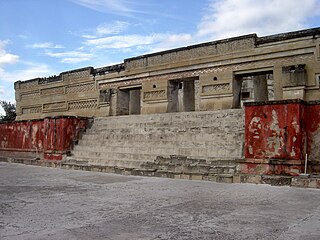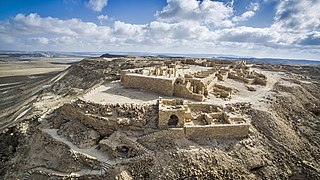Related Research Articles

Amphipolis was an important ancient Greek polis (city), and later a Roman city, whose large remains can still be seen. It gave its name to the modern municipality of Amphipoli, in the Serres regional unit of northern Greece.

Petra, originally known to its inhabitants as Raqmu, is a historic and archaeological city in southern Jordan. Famous for its rock-cut architecture and water conduit systems, Petra is also called the "Rose City" because of the colour of the sandstone from which it is carved. The city is one of the New 7 Wonders of the World and a UNESCO World Heritage Site.

A mosaic is a pattern or image made of small regular or irregular pieces of colored stone, glass or ceramic, held in place by plaster/mortar, and covering a surface. Mosaics are often used as floor and wall decoration, and were particularly popular in the Ancient Roman world.

Jerash is a city in northern Jordan. The city is the administrative center of the Jerash Governorate, and has a population of 50,745 as of 2015. It is located 30.0 miles north of the capital city Amman.

Mitla is the second-most important archeological site in the state of Oaxaca in Mexico, and the most important of the Zapotec culture. The site is located 44 km from the city of Oaxaca, in the upper end of the Tlacolula Valley, one of the three cold, high valleys that form the Central Valleys Region of the state. At an elevation of 4,855 ft, surrounded by the mountains of the Sierra Madre del Sur, the archeological site is within the modern municipality of San Pablo Villa de Mitla. It is 24 mi (38 km) southeast of Oaxaca city. While Monte Albán was the most important politically of the Zapotec centers, Mitla became the main religious one in a later period as the area became dominated by the Mixtec.

Mount Nebo is an elevated ridge located in Jordan, approximately 700 metres (2,300 ft) above sea level. Part of the Abarim mountain range, Mount Nebo is mentioned in the Bible as the place where Moses was granted a view of the Promised Land before his death. The view from the summit provides a panorama of the West Bank across the Jordan River valley. The city of Jericho is usually visible from the summit, as is Jerusalem on a very clear day. The biblical town of Nebo, now known as Khirbet al-Mukhayyat, is located 3.5 km away.

Avdat or Ovdat, and Abdah or Abde, are the modern names of an archaeological site corresponding to the ancient Nabataean, Roman and Byzantine settlement of Oboda or Eboda in the Negev desert in southern Israel. It was inhabited with intermissions between the 3rd century BCE and the mid-7th century CE by Nabataeans, in their time becoming the most important city on the Incense Route after Petra, then by Roman army veterans, and Byzantines, surviving only for a few years into the Early Muslim period. Avdat was a seasonal camping ground for Nabataean caravans travelling along the early Petra–Gaza road in the 3rd – late 2nd century BCE. The city's original name was changed in honor of Nabataean King Obodas I, who, according to tradition, was revered as a deity and was buried there.

Stobi or Stoboi, was an ancient town of Paeonia, later conquered by Macedon, and finally turned into the capital of the Roman province of Macedonia Salutaris. It is located near Gradsko, North Macedonia, on the main road that leads from the Danube to the Aegean Sea and is considered by many to be the most famous archaeological site in North Macedonia. Stobi was built where the Erigon joins the Axios (Vardar), making it strategically important as a center for both trade and warfare.

Madaba is the capital city of Madaba Governorate in central Jordan, with a population of about 60,000. It is best known for its Byzantine and Umayyad mosaics, especially a large Byzantine-era mosaic map of the Holy Land. Madaba is located 30 kilometres south-west of the capital Amman.

Umm ar-Rasas, ancient name: Kastron Mefa'a, is located 30 km southeast of Madaba in the Amman Governorate in central Jordan. It was once accessible by branches of the King's Highway, and is situated in the semi-arid steppe region of the Jordanian Desert. The site has been associated with the biblical settlement of Mephaat mentioned in the Book of Jeremiah. The Roman military utilized the site as a strategic garrison, but it was later converted and inhabited by Christian and Islamic communities. In 2004, the site was inscribed as a UNESCO World Heritage Site, and is valued by archaeologists for its extensive ruins dating to the Roman, Byzantine, and early Muslim periods. The Franciscan academic society in Jerusalem, Studium Biblicum Franciscanum (SBF), carried out excavations at the north end of the site in 1986, but much of the area remains buried under debris.

The Villa Romana del Casale is a large and elaborate Roman villa or palace located about 3 km from the town of Piazza Armerina, Sicily. Excavations have revealed Roman mosaics which, according to the Grove Dictionary of Art, are the richest, largest and most varied collection that remains, for which the site was designated as a UNESCO World Heritage Site in 1997. The villa and its artwork date to the early 4th century AD.

Jordan is a sovereign Arab state in the Middle East. The capital, Amman, is Jordan's most populous city as well as the country's economic, political and cultural centre.

Early Byzantine mosaics in the Middle East are a group of Christian mosaics created between the 4th and the 8th centuries in ancient Syria, Palestine and Egypt when the area belonged to the Byzantine Empire. The eastern provinces of the Eastern Roman Empire and its continuation, the Byzantine Empire, inherited a strong artistic tradition from pagan Late Antiquity. The tradition of making mosaics was carried on in the Umayyad era until the end of the 8th century. The great majority of these works of art were later destroyed but archeological excavations unearthed many surviving examples.

The Tomb of Aaron is the name of the supposed burial place of Aaron, the brother of Moses, according to Jewish, Christian, and local Muslim tradition.

Beidha, also sometimes Bayda, is a major Neolithic archaeological site a few kilometres north of Petra near Siq al-Barid in Jordan. It is included in Petra's inscription as a UNESCO World Heritage Site.

Nabatean architecture refers to the building traditions of the Nabateans, an ancient Arab people who inhabited northern Arabia and the southern Levant. Their settlements—most prominently the assumed capital city of Raqmu —gave the name Nabatene to the Arabian borderland that stretched from the Euphrates to the Red Sea. Their architectural style is notable for its temples and tombs, most famously the ones found in Petra. The style appears to be a mix of Mesopotamian, Phoenician, Hellenisticn, and South Arabian influences modified to suit the Arab architectural taste. Petra, the capital of the kingdom of Nabatea, is as famous now as it was in the antiquity for its remarkable rock-cut tombs and temples. Most architectural Nabatean remains, dating from the 1st century BC to the 2nd century AD, are highly visible and well-preserved, with over 500 monuments in Petra, in modern-day Jordan, and 110 well preserved tombs set in the desert landscape of Hegra, now in modern-day Saudi Arabia. Much of the surviving architecture was carved out of rock cliffs, hence the columns do not actually support anything but are used for purely ornamental purposes. In addition to the most famous sites in Petra, there are also Nabatean complexes at Obodas (Avdat) and residential complexes at Mampsis (Kurnub) and a religious site of et-Tannur.
The American Center of Research (ACOR) is a private, not-for-profit scholarly and educational organization. Based in Alexandria, Virginia, with a facility in Amman, Jordan, ACOR promotes knowledge of Jordan and the interconnected region, past and present. Prior to 2020, ACOR was known as The American Center of Oriental Research.

Little Petra, also known as Siq al-Barid, is an archaeological site located north of Petra and the town of Wadi Musa in the Ma'an Governorate of Jordan. Like Petra, it is a Nabataean site, with buildings carved into the walls of the sandstone canyons. As its name suggests, it is much smaller, consisting of three wider open areas connected by a 450-metre (1,480 ft) canyon. It is part of the Petra Archeological Park, though accessed separately, and included in Petra's inscription as a UNESCO World Heritage Site. It is often visited by tourists in conjunction with Petra itself, since it is free and usually less crowded.

The Byzantine Church at Petra is a prime example of monumental architecture in Byzantine Petra. It sits on elevated ground in the city center, north of the so-called Colonnaded Street. It is one of three Byzantine churches on the hillside, the others two being the Ridge Church and the Blue Chapel, the 5th - 6th century chapel north of the main church, so called because it was fashioned with blue Egyptian granite.

The architecture of Jordan has been subject to vast development, specifically in the final years of the twentieth century. Jordan is a semi-arid country located in the Middle East. Its location has great significance to Christians, Muslims and Jews as it is considered part of the Holy Land.
References
- 1 2 "Petra Churches". viajordan.com.
- 1 2 "Petra: The North Ridge". Acor Jordan. Retrieved 2021-06-21.
- ↑ Maynor Bikai, Patricia; Perry, Megan A. (November 2001). "Petra North Ridge Tombs 1 and 2: Preliminary Report". Bulletin of the American Schools of Oriental Research. 324: 59–78. doi:10.2307/1357632.
- ↑ Picture of the Ridge Church, flickr.com.
- 1 2 Bikai, Patricia (2004). "Petra: North Ridge Project". Studies in the History and Archaeology of Jordan. 8: 59–63.